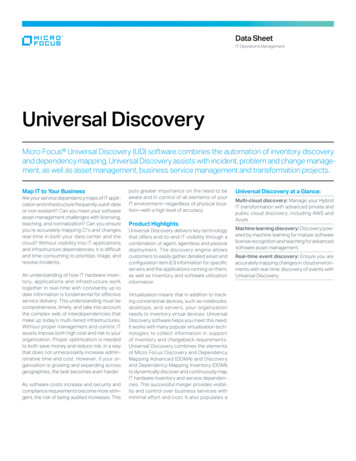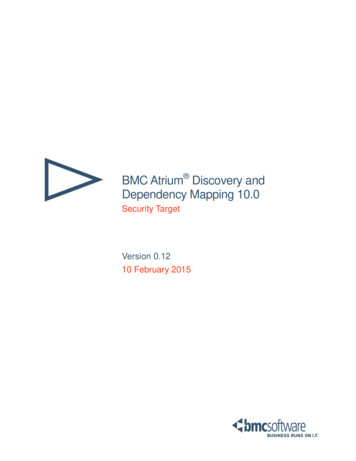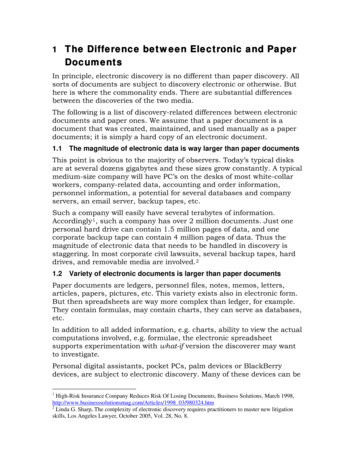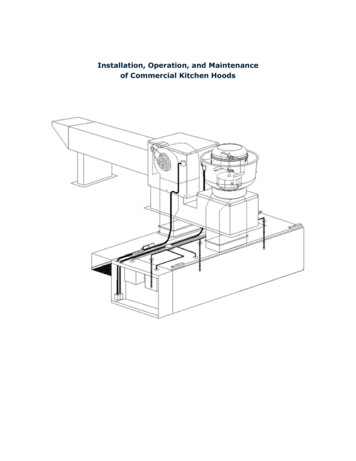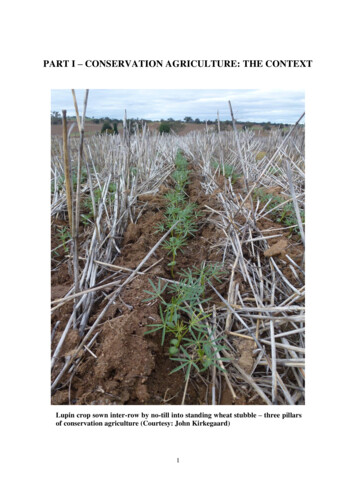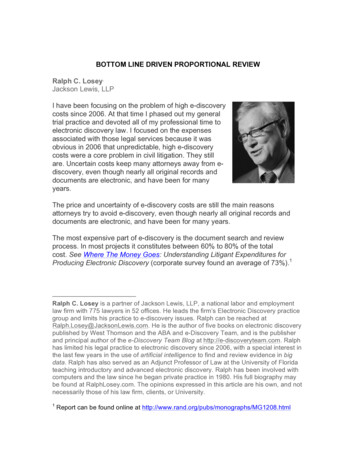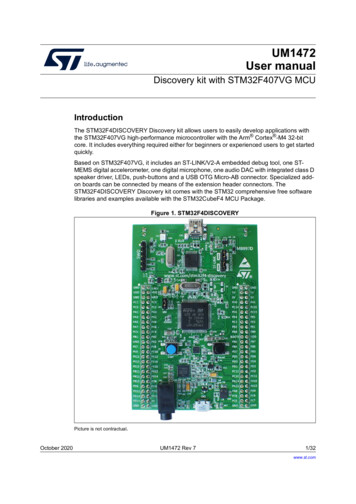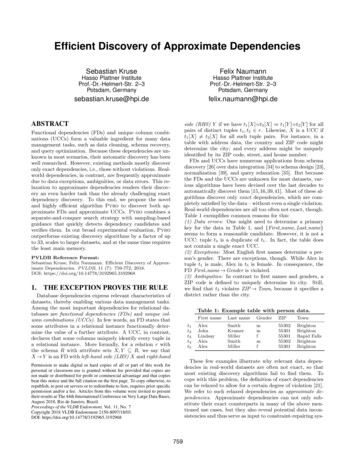
Transcription
Efficient Discovery of Approximate DependenciesSebastian KruseFelix NaumannHasso Plattner InstituteProf.-Dr.-Helmert-Str. 2–3Potsdam, GermanyHasso Plattner InstituteProf.-Dr.-Helmert-Str. 2–3Potsdam, BSTRACTside (RHS) Y if we have t1 [X] t2 [X] t1 [Y ] t2 [Y ] for allpairs of distinct tuples t1 , t2 r. Likewise, X is a UCC ift1 [X] 6 t2 [X] for all such tuple pairs. For instance, in atable with address data, the country and ZIP code mightdetermine the city; and every address might be uniquelyidentified by its ZIP code, street, and house number.FDs and UCCs have numerous applications from schemadiscovery [26] over data integration [34] to schema design [23],normalization [39], and query relaxation [35]. But becausethe FDs and the UCCs are unknown for most datasets, various algorithms have been devised over the last decades toautomatically discover them [15,16,39,41]. Most of these algorithms discover only exact dependencies, which are completely satisfied by the data – without even a single violation.Real-world dependencies are all too often not exact, though.Table 1 exemplifies common reasons for this:(1) Data errors: One might need to determine a primarykey for the data in Table 1, and {First name, Last name}seems to form a reasonable candidate. However, it is not aUCC: tuple t4 is a duplicate of t1 . In fact, the table doesnot contain a single exact UCC.(2) Exceptions: Most English first names determine a person’s gender. There are exceptions, though. While Alex intuple t1 is male, Alex in t5 is female. In consequence, theFD First name Gender is violated.(3) Ambiguities: In contrast to first names and genders, aZIP code is defined to uniquely determine its city. Still,we find that t3 violates ZIP Town, because it specifies adistrict rather than the city.Functional dependencies (FDs) and unique column combinations (UCCs) form a valuable ingredient for many datamanagement tasks, such as data cleaning, schema recovery,and query optimization. Because these dependencies are unknown in most scenarios, their automatic discovery has beenwell researched. However, existing methods mostly discoveronly exact dependencies, i.e., those without violations. Realworld dependencies, in contrast, are frequently approximatedue to data exceptions, ambiguities, or data errors. This relaxation to approximate dependencies renders their discovery an even harder task than the already challenging exactdependency discovery. To this end, we propose the noveland highly efficient algorithm Pyro to discover both approximate FDs and approximate UCCs. Pyro combines aseparate-and-conquer search strategy with sampling-basedguidance that quickly detects dependency candidates andverifies them. In our broad experimental evaluation, Pyrooutperforms existing discovery algorithms by a factor of upto 33, scales to larger datasets, and at the same time requiresthe least main memory.PVLDB Reference Format:Sebastian Kruse, Felix Naumann. Efficient Discovery of Approximate Dependencies. PVLDB, 11 (7): 759-772, 2018.DOI: https://doi.org/10.14778/3192965.31929681.THE EXCEPTION PROVES THE RULEDatabase dependencies express relevant characteristics ofdatasets, thereby enabling various data management tasks.Among the most important dependencies for relational databases are functional dependencies (FDs) and unique column combinations (UCCs). In few words, an FD states thatsome attributes in a relational instance functionally determine the value of a further attribute. A UCC, in contrast,declares that some columns uniquely identify every tuple ina relational instance. More formally, for a relation r withthe schema R with attribute sets X, Y R, we say thatX Y is an FD with left-hand side (LHS) X and right-handTable 1: Example table with person data.t1t2t3t4t5First nameLast ightonBrightonRapid FallsBrightonBrightonThese few examples illustrate why relevant data dependencies in real-world datasets are often not exact, so thatmost existing discovery algorithms fail to find them. Tocope with this problem, the definition of exact dependenciescan be relaxed to allow for a certain degree of violation [21].We refer to such relaxed dependencies as approximate dependencies. Approximate dependencies can not only substitute their exact counterparts in many of the above mentioned use cases, but they also reveal potential data inconsistencies and thus serve as input to constraint-repairing sys-Permission to make digital or hard copies of all or part of this work forpersonal or classroom use is granted without fee provided that copies arenot made or distributed for profit or commercial advantage and that copiesbear this notice and the full citation on the first page. To copy otherwise, torepublish, to post on servers or to redistribute to lists, requires prior specificpermission and/or a fee. Articles from this volume were invited to presenttheir results at The 44th International Conference on Very Large Data Bases,August 2018, Rio de Janeiro, Brazil.Proceedings of the VLDB Endowment, Vol. 11, No. 7Copyright 2018 VLDB Endowment 2150-8097/18/03.DOI: https://doi.org/10.14778/3192965.3192968759
tems [7, 13, 19, 24, 42]. Furthermore, approximate dependencies can help to improve poor cardinality estimates of queryoptimizers by revealing correlating column sets [17, 27]; andthey can support feature selection for machine learning algorithms (especially for those assuming mutual independenceof features) by exposing dependent feature sets [10].Unfortunately, their discovery is more challenging than isthe case for their exact counterparts. The main challengeof both FD and UCC discovery is the huge search spacethat grows exponentially with the number of attributes in adataset. To cope, exact discovery algorithms employ aggressive pruning: As soon as they find a single counter-examplefor a dependency candidate, they can immediately prunethis candidate [39, 41]. This obviously does not work whenviolations are permitted. Hence, a new strategy is called forto efficiently determine approximate dependencies.We present Pyro, a novel algorithm to discover approximate FDs (AFDs) and approximate UCCs (AUCCs) witha unified approach based on two principal ideas. The firstis to use focused sampling to quickly hypothesize AFD andAUCC candidates. The second idea is to traverse the searchspace in such a way, that we can validate the dependencycandidates with as little effort as possible.The remainder of this paper is structured as follows. InSection 2, we survey related work and highlight Pyro’s novelcontributions. Then, we precisely define the problem of finding AFDs and AUCCs in Section 3 and outline Pyro’s approach to this problem in Section 4. Having conveyed thebasic principles of our algorithms, we then proceed to describe its components in more detail. In particular, we describe how Pyro efficiently estimates and calculates the error of AFD and AUCC candidates in Section 5 and elaborateon its focused search space traversal in Section 6. Then, weexhaustively evaluate Pyro and compare it to three stateof-the-art discovery algorithms in Section 7. We find thatPyro is in most scenarios the most efficient among the algorithms and often outperforms its competitors by orders ofmagnitude. Finally, we conclude in Section 8.2.AFDs according to an entropy-based measure without evaluating the qualitative impact of this restriction.Another approach to harness the complexity is to useheuristics to prune potentially uninteresting AFD candidates [40]. Because this can cause the loss of interesting results, Pyro instead discovers all approximate dependenciesfor some given error threshold and leaves filtering or ranking of the dependencies to use-case specific post-processing.This prevents said loss and also frees users from the burdenof selecting an appropriate interestingness threshold.Along these lines, exact approaches for the discovery ofAFDs and AUCCs have been devised. Arguably, the mostadapted one is Tane [16], which converts the columns of aprofiled relation into stripped partitions (also: position listindices, PLIs) and exhaustively combines them until it hasdiscovered the minimal approximate dependencies. Beingmainly designed for exact FD and UCC discovery, some ofTane’s pruning rules do not work in the approximate case,leading to degraded performance. In fact, before discovering an approximate dependency involving n columns, Tanetests 2n 2 candidates corresponding to subsets of thesecolumns. Note that many works build upon Tane withoutchanging these foundations [5, 20, 28]. Pyro avoids theseproblems by estimating the position of minimal approximatedependencies and then immediately verifying them.Further approaches to infer approximate dependencies arebased on the pairwise comparison of all tuples. The Fdep algorithm proposes (i) to compare all tuple pairs in a database,thereby counting any FD violations; (ii) to apply an errorthreshold to discard infrequent violations; and (iii) to deducethe AFDs from the residual violations [11, 12]. We foundthis algorithm to yield incorrect results, though: Unlike exact FDs, AFDs can be violated by combinations of tuplepair-based violations, which Step (ii) neglects. In additionto that, the quadratic load of comparing all tuple pairs doesnot scale well to large relations [37]. In a related approach,Lopes et al. propose to use tuple pair comparisons to determine the most specific non-FDs in a given dataset whoseerror should then be calculated subsequently [30]. This approach is quite different from the aforementioned ones because it discovers only a small subset of all AFDs.In a different line of work, an SQL-based algorithm forAFD discovery has been proposed [33]. As stated by theauthors themselves, the focus of that work lies on ease of implementation in practical scenarios rather than performance.Last but not least, the discovery of dependencies in thepresence of NULL values has been studied [23]. This workconsiders replacements for NULL values, such that exact dependencies emerge. This problem is distinct from that ofPyro, which does not incorporate a special treatment ofNULL but considers arbitrary dependency violations.Exact dependency discovery.Many algorithms forthe discovery of exact FDs and UCCs have been devised,e.g., [15, 16, 39, 41]. These algorithms can generally be divided into (i) those that are based on the pairwise comparisons of tuples and scale well with the number of attributesand (ii) those that are based on PLI intersection and scalewell with the number of tuples [37].The algorithms Ducc [15] and the derived Dfd [2] belong to the latter and resemble Pyro in that they use adepth-first search space traversal strategy. Still, both exhibit substantial differences: While Ducc and Dfd performa random walk through the search space, Pyro performsRELATED WORKDependency discovery has been studied extensively in thefield of data profiling [1]. The efficient discovery of exactFDs has gained particular interest [37]. Further, many extensions and relaxations of FDs have been proposed [9], e.g.,using similarity functions, aggregations, or multiple datasources. Pyro focuses on approximate dependencies thatmay be violated by a certain portion of tuples or tuple pairs.Note that this is different from dependency approximationalgorithms [8, 22], which trade correctness guarantees of thediscovered dependencies for performance improvements. Inthe following, we focus on those works that share goals orhave technical commonalities with Pyro.Approximate dependency discovery. While there aremany works studying the discovery of FDs under variousrelaxations, only relatively few of them consider approximate FDs. To cope with the problem complexity, some discovery algorithms operate on samples of the profiled dataand therefore cannot guarantee the correctness of their results [17, 22, 31] (that is, they only approximate the approximate FDs). This does not apply to Pyro. In addition,Cords discovers only unary AFDs [17], which is a mucheasier problem; and the authors of [31] detect only the top k760
a sampling-based best-first search along with other techniques to reduce the number of dependency candidate tests.Interestingly, the authors of Dfd suggest that it could bemodified to discover AFDs and we will therefore consider amodified version of this algorithm in our evaluation.The recent HyFD algorithm manages to scale well withgrowing numbers of tuples and columns by combining tuplecomparisons and PLI intersections [38]. Pyro also combines these two base techniques. However, HyFD aggressively prunes FDs as soon as it discovers a violation of thesame. While this pruning is key to HyFD’s efficiency, itis not applicable to approximate dependencies. Instead,Pyro uses tuple comparisons to hypothesize dependencycandidates rather than falsifying them and its search spacetraversal is adaptive rather than bottom-up.Lattice search. In a broader sense, Pyro classifies nodesin a power set lattice, as we explain in Section 3. Apartfrom dependency discovery, several other problems, such asfrequent itemset mining [3, 14], belong in this category andcan be tackled with the same algorithmic foundations [32].For instance, AFD discovery can be modeled as a frequentitemset mining problem; however, such adaptations requireadditional tailoring to be practically usable [40].3.AFD has an AFD error of at most eφ , while all its generalizations have an AFD error greater than eφ . Analogously, aminimal AUCC has an AUCC error of at most eυ , while allits generalizations have an AUCC error greater than eυ .Example 2. Assume we want to find all minimal AUCCs inTable 1 with the error threshold of eυ 0.1. Amongst others, υ1 {First name, Last name} and υ2 {First name,Last name, Gender} have an AUCC of 0.1 eυ . However,υ1 is a generalization of υ2 , so υ2 is not minimal and neednot be discovered explicitly.Let us finally explain, why we exclude AFDs with composite RHSs, i.e., with more than one attribute. For exactdependency discovery, this exclusion is sensible because theFD X AB holds if and only if X A and X B hold [4].For AFDs as defined in Definition 1, this is no longer thecase. However, considering composite RHSs potentially increases the number of AFDs drastically and might have serious performance implications. Furthermore, it is not clearhow the use cases mentioned in Section 1 would benefit fromsuch additional AFDs, or whether they would even be impaired by their huge number. Hence, we deliberately focuson single RHSs for pragmatic reasons and do so in accordance with related work [12, 16, 30]. Nevertheless, it can beshown that an AFD X AB can hold only if both X Aand X B hold. Hence, AFDs with a single RHS can beused to prune AFD candidates with composite RHSs.PROBLEM STATEMENTBefore outlining our algorithm Pyro, let us formalizethe problem of finding the AFDs and AUCCs in a dataset.When referring to approximate dependencies, we need toquantify the degree of approximation. For that purpose, weuse a slight adaptation of the well-established g1 error [21]that ignores reflexive tuple pairs.4.Before detailing Pyro’s individual components, let us outline with the help of Algorithm 1 and Figure 1 how Pyrodiscovers all minimal AFDs and AUCCs for a given datasetand error thresholds eφ and eυ . For simplicity (but withoutloss of generality), we assume eφ eυ emax for some userdefined emax . Furthermore, we refer to AFD and AUCCcandidates with an error emax as dependencies and otherwise as non-dependencies. Now, given a dataset with nattributes, Pyro spawns n 1 search spaces (Line 1): onesearch space per attribute to discover the minimal AFDswith that very attribute as RHS; and one search space forAUCCs. The AUCC search space is a powerset lattice ofall attributes, where each attribute set directly forms anAUCC candidate. Similarly, each AFD search space is apowerset lattice with all but the RHS attribute A, whereeach attribute set X represents the AFD candidate X A.In other words, each attribute set in the powerset latticesforms a unique dependency candidate. We may therefore useattribute sets and dependency candidates synonymously.In a second preparatory step before the actual dependency discovery, Pyro builds up two auxiliary data structures (called agree set sample (AS) cache and position listindex (PLI) cache; Lines 2–3), both of which support thediscovery process for all search spaces by estimating or calculating the error of dependency candidates. We explainthese data structures in Section 5.Eventually, Pyro traverses each search space with a separate-and-conquer strategy to discover their minimal dependencies (Lines 4–5). Said strategy employs computationallyinexpensive error estimates (via the AS cache) to quicklylocate a promising minimal dependency candidate and thenefficiently checks it with only few error calculations (via thePLI cache). As indicated in Figure 1, the verified (non-)dependencies are then used to prune considerable parts ofDefinition 1 (AFD/AUCC error). Given a dataset r and anAFD candidate X A, we define its error ase(X A, r) {(t1 , t2 ) r2 t1 [X] t2 [X] t1 [A]6 t2 [A]} r 2 r Analogously, the error of an AUCC candidate X is defined ase(X, r) ALGORITHM OVERVIEW {(t1 , t2 ) r2 t1 6 t2 t1 [X] t2 [X]} r 2 r Example 1. For Table 1, we can calculate e(First name Gender, r) 524 5 0.2 (violated by (t1 , t5 ), (t4 , t5 ), andtheir inverses) and e({First name, Last name}, r) 522 5 0.1 (violated by (t1 , t4 ) and its inverse).These error measures lend themselves for Pyro for tworeasons. First, and as we demonstrate in Section 5, they canbe easily calculated from different data structures. Second,and more importantly, they are monotonous. That is, forany AFD X Y and an additional attribute A we havee(X Y ) e(XA Y ). Likewise for an AUCC X, we havee(X) e(XA). In other words, adding an attribute to theLHS of an AFD or to an AUCC can only remove violationsbut not introduce new violations. We refer to those XA Yand XA, respectively, as specializations and to X Y andX, respectively, as generalizations. With these observations,we can now precisely define our problem statement.Problem Statement . Given a relation r and error thresholdseφ and eυ , we want to determine all minimal AFDs with asingle RHS attribute and all minimal AUCCs. A minimal761
directly calculated on them, as we show in the next section.Finally, π̄(XY ) can be efficiently calculated from π̄(X) andπ̄(Y ) [16], denoted as intersecting PLIs. In consequence, wecan represent any combination of attributes as a PLI.For clarity, let us briefly describe the PLI intersection.As an example, consider the data from Table 1 and assumewe want to intersect the PLIs π̄(Firs name) {{1, 4, 5}}and π̄(Last name) {{1, 4}, {2, 5}}. In the first step, weconvert π̄(Last name) into the attribute vector vLast name (1, 0, 2, 1, 2), which simply is a dictionary-compressed arrayof the attribute Last name with one peculiarity: All valuesthat appear only once are encoded as 0. This conversionis straight-forward: For each cluster in π̄(Last name), wesimply devise an arbitrary ID and write this ID into thepositions contained in that cluster. In the second step, theprobing, we group the tuple indices within each cluster ofπ̄(First name). Concretely, the grouping key for the tupleindex i is the i-th value in vLast name unless that value is0: In that case the tuple index is dropped. For the cluster{1, 4, 5}, we obtain the groups 1 {1, 4} and 2 {5}.Eventually, all groups with a size greater than 1 form thenew PLI. In our example, we get π̄(First name, Last name) {{1, 4}}. Because t1 and t4 are the only tuples in Table 1that agree in both First name and Last name, our calculated PLI indeed satisfies Definition 2.That being said, intersecting PLIs is computationally expensive. Therefore, Pyro puts calculated PLIs into a PLIcache (cf. Figure 1) for later reuse. Caching PLIs has beenproposed in context of the Ducc algorithm [15] (and wasadopted by Dfd [2]), however, a description of the cachingdata structure has not been given. It has been shown, however, that the set-trie of the Fdep algorithm [12] is suitableto index and look up PLIs [43].As exemplified in Figure 2, Pyro’s PLI cache adopts asimilar strategy: It is essentially a trie (also: prefix tree)that associates attribute sets to their respective cached PLI.Assume we have calculated π̄({C, E}). Then we convert thisattribute set into the list (C, E), which orders the attributesaccording to their order in the relation schema. Then, weindex π̄({C, E}) in the trie using (C, E) as key.However, when Pyro requests some PLI π̄(X), it maywell not be in the cache. Still, we can leverage the cache byBCDEaddressing Athe followingcriteria:(1) Weobtain s 665π̄(X) withonly fewPLI intersections.s 944s 823want tos 994s 813(2) In every intersection π̄(Y ) π̄(Z), where we probe π̄(Y )BagainstvZ ,Dwe would like kπ̄(Y )k to be small.While Criterion 1 addresses the number of PLI intersections, Criterion 2 addresses the efficiency of the individualCDEintersections, because probing few, small PLI clusters is beneficials 42performance-wise.Algorithm 2 considers both criterias 23s 102to serve PLI requests utilizing the PLI cache. As an example, assume we want to construct the PLI π̄(ABCDE) withAlgorithm 1: Pyro’s general workflow.Data: Relation schema R with instance r, AFD errorthreshold eφ , AUCC error threshold eυ. Section 41 search-spaces {create-aucc-space(R, eυ )} SA R create-afd-space(R \ {A}, A, eφ ). Section 52 pli-cache init-pli-cache(r)3 as-cache init-as-cache(r, pli-cache). Section 64 foreach space search-spaces do5traverse(space, pli-cache, as-cache)AFD search space (RHS A)AUCC search spaceAS cachePLI cachedependency candidate(non-)AFD/AUCCinferred (non-)AFD/AUCCFigure 1: Intermediate state of Pyro while profilinga relation with the schema R (A, B, C, D).the search space and as a result Pyro needs to inspect onlythe residual dependency candidates. Notice that our traversal strategy is sufficiently abstract to accommodate bothAFD and AUCC discovery without any changes.5.ERROR ASSESSMENTAs Pyro traverses a search space, it needs to estimate andcalculate the error of dependency candidates. This sectionexplains the data structures and algorithms to perform bothoperations efficiently.5.1PLI CacheAs we shall see in the following, both the error estimation and calculation involve position list indices (PLIs) (alsoknown as stripped partitions [16]):Definition 2 (PLI). Let r be a relation with schema R andlet X R be a set of attributes. A cluster is a set ofall tuple indices in r that have the same value for X, i.e.,c(t) {i ti [X] t[X]}. The PLI of X is the set of all suchclusters except for singleton clusters:π̄(X) : {c(t) t r c(t) 1}We further define the size of a PPLI as the number of includedtuple indices, i.e., kπ̄(X)k : c π̄(X) c .Example 3. Consider the attribute Last name in Table 1. Itsassociated PLI consists of the clusters {1, 4} for the valueSmith and {3, 5} for the value Miller. The PLI does notinclude the singleton cluster for the value Kramer, though.APyro (and many related works, for that matter) employPLIs for various reasons. First, and that is specific to Pyro,PLIs allow to create focused samples on the data, therebyenabling precise error estimates of dependency candidates.Second, PLIs have a low memory footprint because theystore only tuple indices rather than actual values and omitsingleton clusters completely. Third, the g1 error can bes 823BBs 944Ds 665EDs 42Cs 23Es 994s 813Cached PLIPLI for CE (size 102)s 102Figure 2: Example PLI cache.762Cache nodeBAttribute
Algorithm 2: Retrieve a PLI from the PLI cache.Data: PLI cache cache, attribute set X1 Π lookup PLIs for subsets of X in cache2 π̄(Y ) pick the smallest PLI indices from Π3 Z new list, C Y4 while C X do5π̄(Z) pick PLI from Π that maximizes Z \ C 6append π̄(Z) to Z7C C Z11sort Z by the PLIs’ sizes, C Yforeach π̄(Z) Z doπ̄(C Z) π̄(C) π̄(Z), C C Zif coin flip shows head then put π̄(C) into cache12return π̄(C)8910Algorithm 3: Error calculation for AFDs and AUCCs.123456789Function e(X A, r) calc-AFD-error(π̄(X), vA , r)e 0foreach c π̄(X) docounter dictionary with default value 0foreach i c doif vA [i] 6 0 then increase counter[vA [i]] P e e c 2 c cA counter c2A cA10returne r 2 r number of tuple pairs also agreeing in A (Lines 4–8) andthen subtract this number from all tuple pairs in the cluster(Lines 9–10). For this calculation, we need the attributevector vA of attribute A (cf. Section 5.1), in addition toπ̄(X). Note that we must not count zeros in vA , becausethey represent singleton values. By summing the errors ofall clusters in π̄(X), we finally obtain e(X A, r).the PLI cache from Figure 2. At first, we look up all PLIsfor subsets of ABCDE in the cache (Line 1). This look-upcan be done efficiently in tries. Among the retrieved PLIs,we pick the one π̄(Y ) with the smallest size (Line 2). In ourexample, this is the case for π̄(AD) with a size of 23. Thissmallest PLI shall be used for probing in the first PLI intersection. The resulting PLI, which cannot be larger in size,will then be used for the subsequent intersection’s probingand so on. This satisfies Criterion 2.Next, we need to determine the remaining PLIs to probeagainst. Here, we follow Criterion 1 and repeatedly pickwhatever PLI provides the most new attributes to those inthe already picked PLIs (Lines 3–7). In our example, wethus pick π̄(CE), which provides two new attributes, andthen π̄(B). Finally, all attributes in ABCDE appear in atleast one of the three selected PLIs. Note that Pyro alwaysmaintains PLIs for the single attributes in the PLI cacheand can therefore serve any PLI request.Having selected the PLIs, we intersect them using smallPLIs as early as possible due to Criterion 2 (Lines 8–10).For our example, this yields the intersection order (π̄(AD) π̄(CE)) π̄(B). Compared to intersecting PLIs of singleattributes, we save two out of four intersection operations.Additionally, we can use the PLI π̄(AD), which is muchsmaller than any single-attribute PLI. Hence, the PLI cacheis useful to address both Criteria 1 and 2.Finally, we cache randomly selected PLIs (Line 11).Caching all calculated PLIs would quickly fill the cachewith redundant PLIs or those that will not be needed again.Our random approach, in contrast, caches frequently neededPLIs with a higher probability – with virtually no overhead.5.2Function e(X, r) calc-AUCC-error(π̄(X), r)P c 2 c return c π̄(X) r 2 r 5.3Estimating Dependency ErrorsA key idea of Pyro is to avoid costly PLI-based error calculations by estimating the errors of dependency candidatesand only then conduct a few targeted error calculations. Asa matter of fact, an error calculation can be orders of magnitudes slower than an error estimation. Generally speaking,we can estimate dependency errors by comparing a subset oftuples – or better: a subset of tuple pairs – and extrapolatethe number of encountered violations to the whole relation.Such error estimation is related to (but far more efficientthan) algorithms that exhaustively compare all tuple pairsto discover dependencies [12,30]. The basis for this approachare agree set samples (AS samples).Definition 3 (AS sample). Given a relational instance r withschema R and two tuples t1 , t2 r, their agree set [6] isag(t1 , t2 ) : {A R t1 [A] t2 [A]}.1 Further, let s r2be a sample of tuple pairs of the relational instance r. Then,s induces the AS sampleAS : {(a, c(a)) (t1 , t2 ) s : a ag(t1 , t2 )}where c(a) : {(t1 , t2 ) s a ag(t1 , t2 )} counts thenumber of occurrences of each agree set in s.Example 4. Assume that we randomly sample three tuplepairs from Table 1, e.g., (t1 , t3 ), (t1 , t5 ), and (t2 , t3 ). Thisgives us the AS sample AS {({Gender, Town}, 1),({First name, Town}, 1), ({Gender, ZIP}, 1)}.Evaluating Dependency CandidatesPLIs are vital to calculate the error of an AFD or AUCC,respectively. Having shown how to efficiently obtain the PLIfor some attribute set X, let us show how to calculate theg1 error (see Definition 1) from π̄(X) in Algorithm 3.For an AUCC candidate X, the error calculation givenπ̄(X) is trivial: We merely count all tuple pairs inside ofeach cluster because these are exactly the violating tuplepairs (Lines 1–2). In contrast, the error calculation of anAFD candidate X A is a bit more complex. Accordingto Definition 1, those tuple pairs violate X A that agreein X and disagree in A. We do not count these tuple pairsdirectly. Instead, for each cluster of π̄(X) we calculate theNow to estimate AFD and AUCC errors from an AS sample AS, we define a query that reports the number of agreesets in AS that include some attribute set inc and do notcontain any attribute of a further attribute set exc:X c if inc a exc a count(AS, inc, exc) : 0 otherwise(a,c) AS1For improved memory and computation efficiency, we calculate agree sets from cached attribute vectors (see Section 5.1) rather than the original input dataset.763
in some cluster c π̄(X). As an example, consider the PLIπ̄({Zip}) {{1, 4}, {2, 3, 5}} for Table 1. This PLI restrictsthe sampling to tuple pairs from {t1 , t4 } or {t2 , t3 , t5 }.In detail, to sample a tuple pair that agrees in X, we first0 2 c0 select a cluster c0 π̄(X) with a probability of cpairs(X)Pwhere pairs(X) : c π̄(X) c 2 c denote the number ofoverall tuple pairs agreeing in X. That is, the probability ofpicking c0 is proportional to the number of its tuple pairs.Then, we randomly sample two distinct tuples from c0 , sothat each tuple pair within c0 is sampled
seems to form a reasonable candidate. However, it is not a UCC: tuple t 4 is a duplicate of t 1. In fact, the table does not contain a single exact UCC. (2) Exceptions: Most English rst names determine a per-son’s gender. There are exceptions, though. While Alex in tuple t 1 is male, Ale
